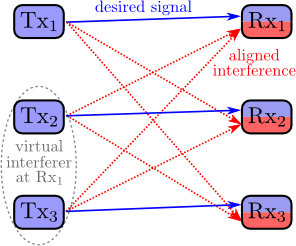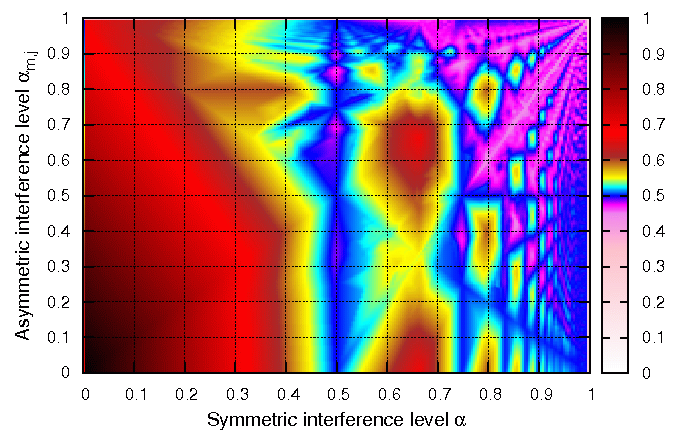Interference Alignment


A typical wireless communication scenario is described by pair-wisely communicating transmitters and receivers. Therein, the impact of interference is the key impairment when dealing with multiple users. It has been a long-standing open problem in communications theory to compute the maximal achievable rates of such a multi-user interference channel.
Recent progress in the research area of communications and information theory provided intriguing insights into the opportunities hidden inside a K-user interference channel. The key idea is to cooperatively align the transmitted signals, such that the aggregated interference signal of multiple transmitters exactly overlaps within a minimized signal space of each receiver. Then, the receiver perceives the interference as if it originates from a single interferer only. This is a very useful property that yields extraordinary data rates which are independent of the number of users within the channel. A conceptional example is depicted for K=3 pairs in the left figure above.
Our main focus is on theoretical modelling and the derivation of capacity-achieving schemes for:
- Cyclic interference alignment via polynomial rings
- Interference alignment with large propagation delays (with applications for underwater communications)
- Interference alignment on linear deterministic interference channels
- MIMO interference alignment with constant channel gains
Related research topics and publications
Cyclic interference alignment and interference alignment by propagation delay
- H. Maier, R. Mathar, Cyclic Interference Alignment and Cancellation in 3-User X-Networks with Minimal Backhaul, Proceedings: IEEE Information Theory Workshop (ITW 2014), Hobart, TAS, Australia, November 2014.
- H. Maier, R. Mathar, User-Relay Duality in Cyclic Interference Alignment for Cascaded Two-Way Relay Networks, Proceedings: IEEE International Symposium on Information Theory and Its Applications (ISITA 2014), Melbourne, VIC, Australia, October 2014.
- H. Maier, R. Mathar, Cyclic Interference Neutralization on the 2x2x2 Full-Duplex Two-Way Relay-Interference Channel, Proceedings: Information Theory Workshop (ITW 2013), Sevilla, Spain, September 2013.
- H. Maier, R. Mathar, Cyclic Interference Neutralization on the Full-Duplex Relay-Interference Channel, Proceedings: IEEE International Symposium on Information Theory (ISIT 2013), Istanbul, Turkey, July 2013.
- H. Maier, J. Schmitz, R. Mathar, Cyclic Interference Alignment by Propagation Delay, Proceedings: 50th Annual Allerton Conference on Communication, Control, and Computing, Monticello, Illinois, USA, October 2012.
- R. Mathar, M. Zivkovic, How to Position n Transmitter-Receiver Pairs in n - 1 Dimensions such that Each Can Use Half of the Channel with Zero Interference from the Others, Proceedings: IEEE Globecom 2009, Honolulu, Hawaii, USA, December 2009.
- R. Mathar, G. Böcherer, On Spatial Patterns of Transmitter-Receiver Pairs that Allow for Interference Alignment by Delay, Proceedings: 3rd International Conference on Signal Processing and Communication Systems (ICSPCS 2009), Omaha, USA , September 2009.
Interference alignment and multi-way communications
- H. Maier, A. Chaaban, R. Mathar, A. Sezgin, Capacity Region of the Reciprocal Deterministic 3-Way Channel via Delta-Y Transformation, Proceedings: 52nd Annual Allerton Conference on Communication, Control and Computing, Monticello, Illinois, USA, October 2014.
- H. Maier, A. Chaaban, R. Mathar, Symmetric Degrees of Freedom of the MIMO 3-Way Channel with M_T x M_R Antennas, Proceedings: IEEE Information Theory Workshop (ITW 2014), Hobart, TAS, Australia, November 2014.
- H. Maier, A. Chaaban, R. Mathar, Degrees of Freedom of the MIMO 3-Way Channel, Proceedings: IEEE International Symposium on Information Theory and Its Applications (ISITA 2014), Melbourne, VIC, Australia, October 2014.
- A. Chaaban, H. Maier, A. Sezgin, The Degrees-of-Freedom of Multi-way Device-to-Device Communications is Limited by 2, Proceedings: IEEE International Symposium on Information Theory (ISIT 2014), Honolulu, USA, July 2014.
- H. Maier, R. Mathar, Uniform and Non-Uniform Delay-Rate Tradeoffs in Partial Ergodic Interference Alignment, Proceedings: IEEE Information Theory Workshop (ITW 2012), Lausanne, Switzerland, September 2012.
- H. Maier, R. Mathar, Max-Min Greedy Interference Alignment on Linear Deterministic K-User Interference Channels, Proceedings: IEEE International Conference on Communications (ICC 2011), Kyoto, Japan, June 2011.
Related projects
- PACIA (DFG COIN)
Related student work
- Open Master Thesis: Interference Alignment by Propagation Delay
- Open Bachelor Thesis: Interference Alignment by Propagation Delay
- Bachelor Thesis Interferenz-Ausrichtung und Lineare Codierung für Linear Deterministische Interferenzkanäle
Contact
For further Information please contact Henning Maier. ***
Aktuelle Informationen gemäß Art. 13 DS-GVO:
Datenschutzhinweis ***
Impressum ***

